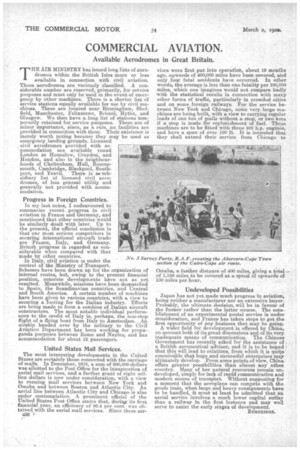COMMERCIAL AVIATION.
Page 26

If you've noticed an error in this article please click here to report it so we can fix it.
Available Aerodromes in Great Britain.
THE AIR MINISTRY has issued long lists of aerodromes within the British Isles more or less available in connection with civil aviation. These aerodromes are variously classified. A considerable number are reserved, primarily, for service purposes and must only be used in the event of emergency by other machines. There is a shorter list of service stations equally available for use by civil machines. These are located near Birmingham, Sheffield, Manchester, Felixstowe, Bristol, Hythe, and Glasgow. We then have .a long list of stations temporarily retained for service purposes. These are of minor importance, since, as a rule, no facilities are provided in connection with them. Their existence is merely worth noting because they may be used as
emergency landing grounds. Licensed \ civil aerodromes provided with accommodation are available round London at Hounslow, Croydon and Hendon, and also in the neiglibourhoods of Cheltenham. Hull, Bourne mouth, Cambridge, Blackpool, South port, and Yeovil. There is aa subsidiary list of licensed civil aerodromes, of less genexal utility and generally not provided with accommodation.
Progress in Foreign Countries.
In my last notes, I endeavoured to summarize recent progress in civil aviation in France and Germany, and mentioned that other countries would be similarly dealt with later. Up to the present, the official conclusion is that our most serious competitors in securing international aircraft trade are France, Italy, and Germany. British progress is regarded as considerable when compared with that Made by other countries.
In Italy, civil aviation is under the control of the Ministry of Transport. Schemes have been drawn up for the organization of internal routes, but, owing to the present financial position, concrete develeprnents have not as yet resulted. Meanwhile, missions have been despatched to Spain, the Scandinavian countries, and Central and S,outh America. A certain number of machines have been given to various countries, with a view to securing a footing for the Italian industry. Efforts are being made to form a combine of Italian aircraft constructors. The most notable individual performance to the credit of Italy is' perhaps, the non-stop flight of a flying boat from Italy to Amsterdam. An airshie handed. over 'by the military to the Civil Aviation Department has been working for propaganda purposes between Rome and Naples, and has accommodation for about 12 passengers.
United States Mail Services.
The most interesting developments in the elnited States are certainly those connected with the carriage of mails. In December, 1918, a sum of 300,000 dollars was allotted to the Pose Office for the inauguration of aerial mail services, and a further grant of eight million dollars is now under consideration, with a view to running mail services between New York and Omaha and between Boston and Atlantic City. An aerial line between Atlantic City and Chicago is also under contemplation. A prominent official of the United States Post Office states that, dining its first financial year, an efficiency of 96.4 per cent. was obtained with the aerial mail services. Since these ser
c36
vices were first put into operation, about 19 months ago, upwards of 400,000 miles have been covered, and only four fatal accidents have occurred. In other words, the average is less than one fatality per 100,000 miles, which one imagines would not compare badly with the statistical results in connection with many other forms of traffic, particularly in crowded cities and on some foreign railways. For the service between New York and Chicago, some very large machines are being built, with a view to carrying regular loads of one ton of pails without a stop', or two ions if a stop is made for replenishment of fuel. These machines are to be fitted with three 400 h.p. engines, and have a span of over 100 ft. It is intended that they shall extend their service from Chicago to Omaha, a Rather distance of 400 miles, giving a total of 1,150 miles to be covered at a, speed of upwards of 100 miles per hour.
Undeveloped Possibilities
Japan has not yet made much progress in aviation, being neither a manufacturer nor an extensive buyer Probably, the ultimate decision, will be in favour of the former rather than the latter course. The establishment of an experimental postal service is under consideration, and France has taken steps to get the first opportunity of any business that may be going.
A wider field for development is offered by China, on account both of its great dimensions and of its very inadequate means of communication. The Chinese Government has recently asked for the assistance of a British aeronautical adviser, and it is to be hoped that this will lead to relations, from which it is quite' conceivable that huge and successful enterprises may ultimately develop. From some points of view, China offers greater possibilities than almost any other, country. Many of her natural resources remain undeveloped, simply for lack of rapid communication and modern means of transport. Without suggesting for a, moment that the aeroplane can compete with the goods train, when large and heavy consignments have to be handled, it must at least be admitted that an aerial service involves a, much lower capital outlay than a railway in the first instance and may well serve to assist the early stages of development. BEMBRTDGE.


































